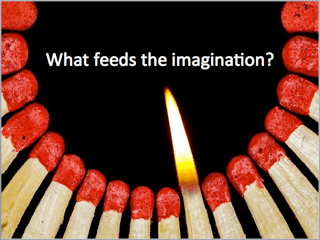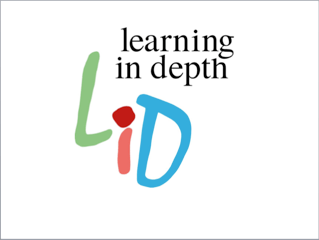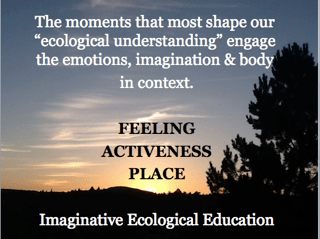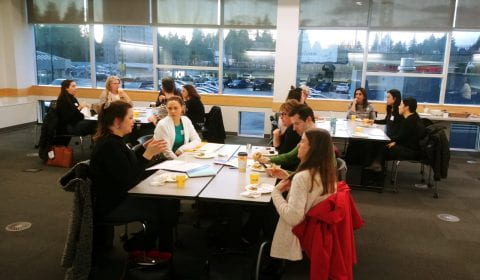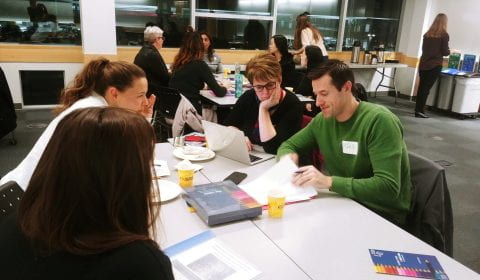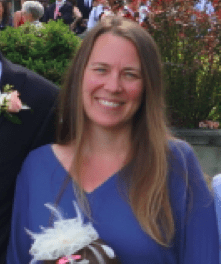 By Cecily Heras (MEd student, SFU; Educator; Coordinator, Imagination Champions Learning Series)
By Cecily Heras (MEd student, SFU; Educator; Coordinator, Imagination Champions Learning Series)
On January 29 it was 8° and rainy around Vancouver. This was boots and raincoats weather. Ugh. But it was our second Imagination Champions session, our cohort was excited to meet up again, and we were ready to hear from Dr. Gillian Judson about Imagination & Inquiry. Miraculously the skies cleared and we were treated to a relatively dry walk to campus; some puddles to navigate, but nothing from the sky. Phew. Our classroom’s blinds were opened and our Imagination Champions were able to appreciate the pale yellow sunset as they shared stories while enjoying a light social dinner. Through the next two hours, the cohort engaged in a lightning introduction to two amazing inquiry programs, had great conversations, and found whispers and screams of imagination around campus on our “Take it to the halls” imaginative challenge.
Gillian first asked us to consider what feeds the imagination. What is the spark that will ignite the match? How can we engage our students so that even a single match might burst into flame with the potential to enflame others? How do we stimulate the growth of imagination in our students? Gillian reminded us that the key to engaging the student’s imagination is knowledge. Our imaginations can go more places with more knowledge–what is possible expands based on what we know. But to know anything, we need depth.
Learning in Depth (LiD)
LiD builds on the assertion that education should include both breadth and depth of knowledge. Education should help students gain a sense about the goings on in our world, how it is and how it came to be this way. In addition to the utilitarian knowledge needed to navigate our lives, LiD explores learning about the nature of knowledge, gaining experience in distinguishing between knowledge and opinion, and using exposure to the arts to help students gain expertise.
In general, our students are well equipped with superficial knowledge. LiD is a simple innovation that can transform schools by offering students an independent, self-directed, formatively assessed and ungraded, long-term inquiry study to immerse themselves in. In one-hour/week sessions, students devote themselves to studying their topics through different mediums and apply cross-curricular knowledge and skills. Different from the passion project, LiD topics and portfolios follow students through their years, conceivably K through 12.
Gillian went on to explain the benefits of LiD (community building, student freedom and intellectual security, etc.), elaborated upon the ‘gifting ceremony’ during which new students receive their topic, and specified that LiD is a student-centered, student-lead approach which requires teacher support. Students may need encouragement to approach topics from new perspectives if frustration occurs. Teachers need to help students learn to investigate and research. Teachers will need to engage students in authentic and relevant conversations.
Through decentering grading and encouraging collaboration and student-developed standards, LiD can cultivate a love of learning and give students a sense of accomplishment and of the interconnectedness of everything. Our cohort recognized that sometimes the ideal of school-wide adoption is not always available… yet. What if they are the only person in the school ready to use LiD? Gillian waylaid these fears. If it’s just you, no problem. Reach out to the online ImaginEd community on facebook and Instagram, or check out a site developed by LiD educator Linda Holmes called livinglearningindepth.com.
Imaginative Ecological Education (IEE)
Part introduction to our next topic, part body-break, Gillian challenged the cohort to team up and find examples of imagination in action outside of the classroom. Our cohort “took it to the halls” with confidence, finding examples in imaginative whispers such as the personalized student study cubicles and the desk set-up in our classroom, to the imaginative scream of the architecture of the building, an upside down boat, portholes included. Though we stayed indoors, dry, warm, and puddle-free, traditionally, IEE does aim to get students outside. Regardless, with this simple exercise, we learned two things: 1. Banana bread builds your imaginative potential – students were encouraged to test this theory and found a direct correlation (and helped polish off our catering platter), and 2. How to take inquiry outside the classroom.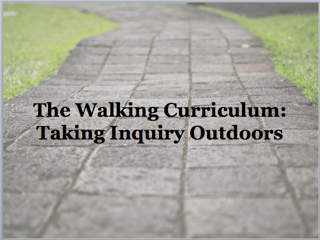
Gillian focused on A Walking Curriculum (TWC), 60 focused outdoor explorations to use with any class. Meant to familiarize students with their local environments in order to encourage ecological understanding, TWC is not a lesson about ecology, but of finding the connections between everything. It is designed to help students develop a real sense of connection with the living world in order to choose to live differently, even in French class!
Remembering that we are moved to action only when we feel something, cognitive tools are key to awakening the imagination, engaging the emotion, and facilitating memory. By developing this sense of place, TWC helps students understand how place influences how they shape their identities and values. To make this point more visceral, Gillian asked the cohort to imagine a place they knew and about which they would be bothered if it disappeared. Any place. Even if they haven’t been there in a while, even if that place has changed. Picture it. Think about it. Remember how you feel/felt about it. That is the sense of place that TWC encourages in students. An awareness of what places really offer, how place can become the silent co-teacher.
Ever ready with helpful practical hints for other practitioners, our cohort pointed out the need for being clear about the purpose of any out-of-classroom activity, establishing time and space parameters, predicting and managing risk, and establishing permission with administration and parents before embarking on outdoor activities. Beyond this, the cohort pointed to the best-practice of accessing students’ prior knowledge and connecting what they know with what they can imagine in order to pull students forward into the mystery of learning. The cohort also stressed the importance of debriefing, without which we as educators have only scratched the surface of the potential of the exercise.
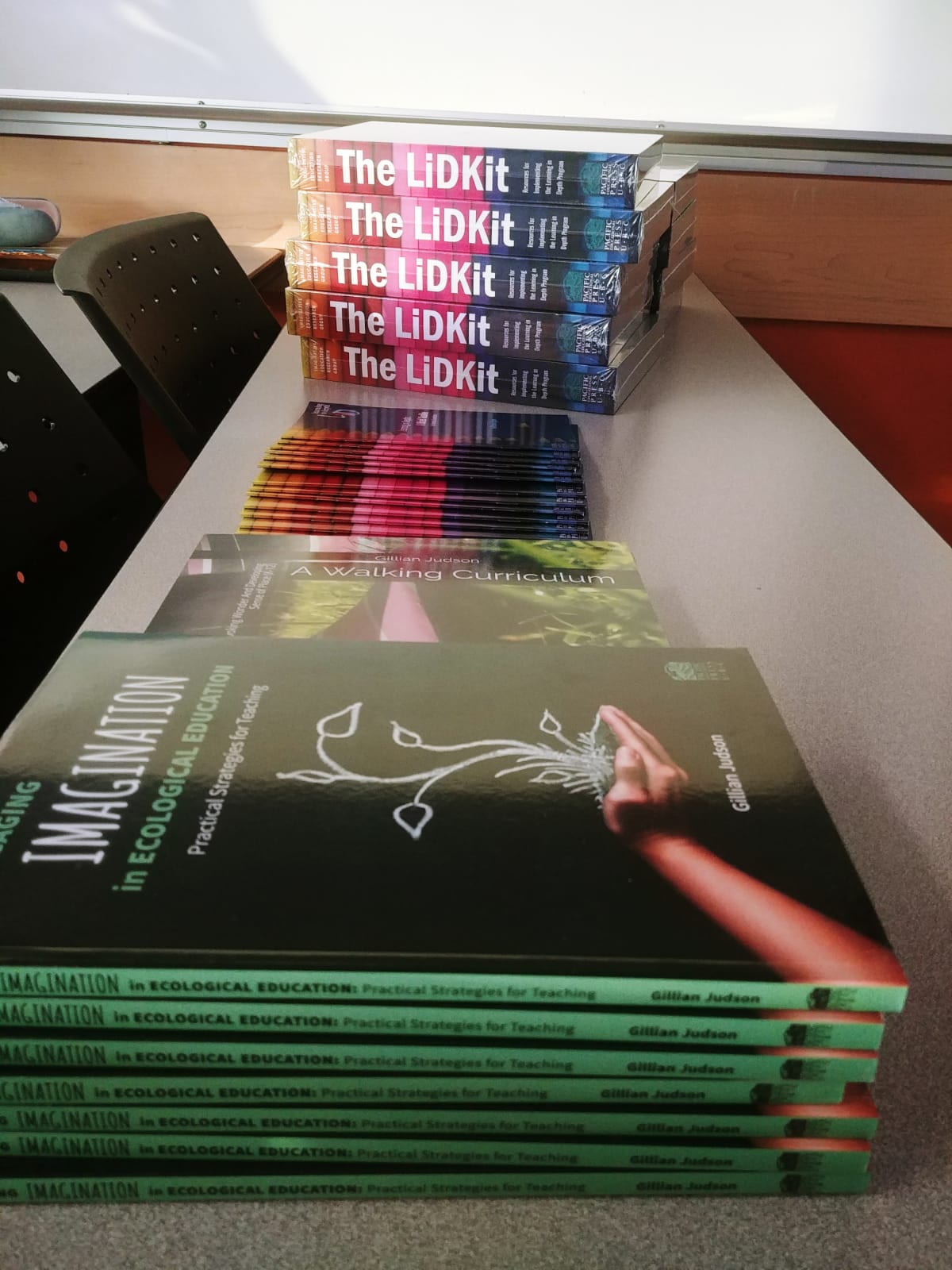 Both of these programs challenge us all to re-envision how and where learning takes place. Once strictly held within four walls and delivered by the teacher for absorption and reproduction from the student, we Imaginative Educators are opening the doors and limits of the classroom, freeing both the minds and bodies of the students in our care. We have each of us signed up to see what is possible in education. Be creative! Be Daring! Be the one who switches the way we view school! Who knows, perhaps you will be the first flame who sparks other matches around you. Go ahead, light that match!
Both of these programs challenge us all to re-envision how and where learning takes place. Once strictly held within four walls and delivered by the teacher for absorption and reproduction from the student, we Imaginative Educators are opening the doors and limits of the classroom, freeing both the minds and bodies of the students in our care. We have each of us signed up to see what is possible in education. Be creative! Be Daring! Be the one who switches the way we view school! Who knows, perhaps you will be the first flame who sparks other matches around you. Go ahead, light that match!
It is with appreciation to our community partner, Envision Financial, that, in addition to the series and dinner, each of our Champions went home with a resource kit to support their understanding of one of these wonderful programs.
Interested in Reading More?
Check out Cecily’s post on the first session of the Imagination Champions Series here.

